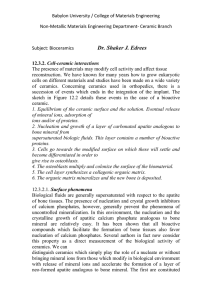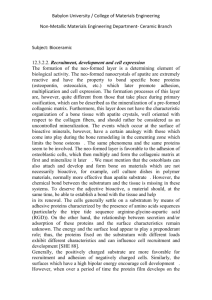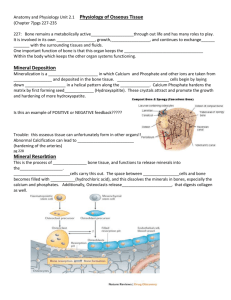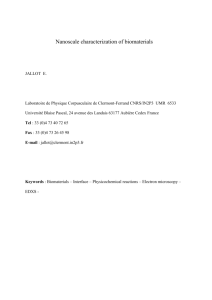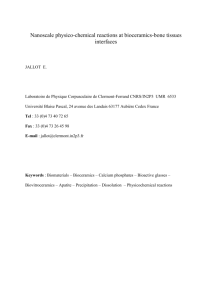pubdoc_11_22596_901
advertisement
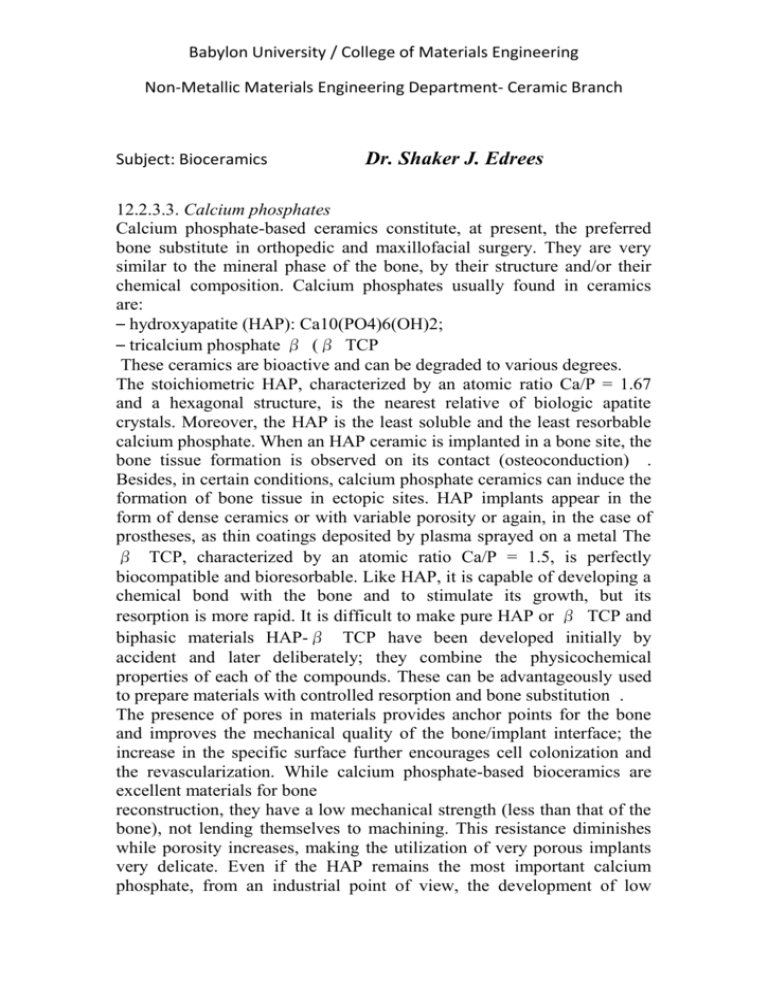
Babylon University / College of Materials Engineering Non-Metallic Materials Engineering Department- Ceramic Branch Subject: Bioceramics Dr. Shaker J. Edrees 12.2.3.3. Calcium phosphates Calcium phosphate-based ceramics constitute, at present, the preferred bone substitute in orthopedic and maxillofacial surgery. They are very similar to the mineral phase of the bone, by their structure and/or their chemical composition. Calcium phosphates usually found in ceramics are: – hydroxyapatite (HAP): Ca10(PO4)6(OH)2; – tricalcium phosphate β (β TCP These ceramics are bioactive and can be degraded to various degrees. The stoichiometric HAP, characterized by an atomic ratio Ca/P = 1.67 and a hexagonal structure, is the nearest relative of biologic apatite crystals. Moreover, the HAP is the least soluble and the least resorbable calcium phosphate. When an HAP ceramic is implanted in a bone site, the bone tissue formation is observed on its contact (osteoconduction) . Besides, in certain conditions, calcium phosphate ceramics can induce the formation of bone tissue in ectopic sites. HAP implants appear in the form of dense ceramics or with variable porosity or again, in the case of prostheses, as thin coatings deposited by plasma sprayed on a metal The β TCP, characterized by an atomic ratio Ca/P = 1.5, is perfectly biocompatible and bioresorbable. Like HAP, it is capable of developing a chemical bond with the bone and to stimulate its growth, but its resorption is more rapid. It is difficult to make pure HAP or β TCP and biphasic materials HAP-β TCP have been developed initially by accident and later deliberately; they combine the physicochemical properties of each of the compounds. These can be advantageously used to prepare materials with controlled resorption and bone substitution . The presence of pores in materials provides anchor points for the bone and improves the mechanical quality of the bone/implant interface; the increase in the specific surface further encourages cell colonization and the revascularization. While calcium phosphate-based bioceramics are excellent materials for bone reconstruction, they have a low mechanical strength (less than that of the bone), not lending themselves to machining. This resistance diminishes while porosity increases, making the utilization of very porous implants very delicate. Even if the HAP remains the most important calcium phosphate, from an industrial point of view, the development of low Babylon University / College of Materials Engineering Non-Metallic Materials Engineering Department- Ceramic Branch Subject: Bioceramics Dr. Shaker J. Edrees temperature processes, particularly those concerning mineral cements and coating on metal, have led to the utilization and emergence of other calcium phosphates which are more reactive. lists the different calcium phosphates used as biomaterials. The development of calcium phosphate-based ceramics at high temperature requires taking into account the thermal stability of these compounds. We can distinguish two schemes of decomposition according to the temperature: irreversible decompositions (condensation of hydrogen phosphate ions, decomposition of carbonate ions, of hydroxide ions, etc.) at low temperature (150–1,000°C) and reversible decomposition (decomposition of the apatite into TCP, TTCP and lime) at high temperatures (T > 1,000°C). 12.2.3.4. Oxides and hydroxides As discussed in the previous section, it would seem that the layer of hydrated silica, formed at the surface of implanted bioglasses and vitroceramics, plays a very important role in the formation of the neoformed apatitic crystals, hence the idea of using pure silica or titanium hydrogels as bioactive compounds. Thus, gels of silica, titanium or zirconia, after being subjected to heat treatment, can induce the formation of the apatite when these are immersed in a metastable solution analogous to biological fluids, while alumina gels are not bioactive. The development through sol-gel processes is an interesting method for the preparation of bioactive materials, since it helps to obtain a product favoring the heterogeneous nucleation of the apatite. While the silica gel is heated to a temperature greater than 900°C, the formation of the apatite is delayed [LI 93a]. It therefore appears that the speed of rehydroxilation and the rate of hydroxyl group on the surface of the silica gel control the formation of apatite. In the same way, sufficiently hydrated titanium dioxide, that is with Ti- OH groups on the surface, can join with the bone while it is placed in a bone site. This property offers the possibility to render titanium bioactive by a treatment before implantation, in such a way as to form a gel or a very hydrated layer at the surface of the implant
